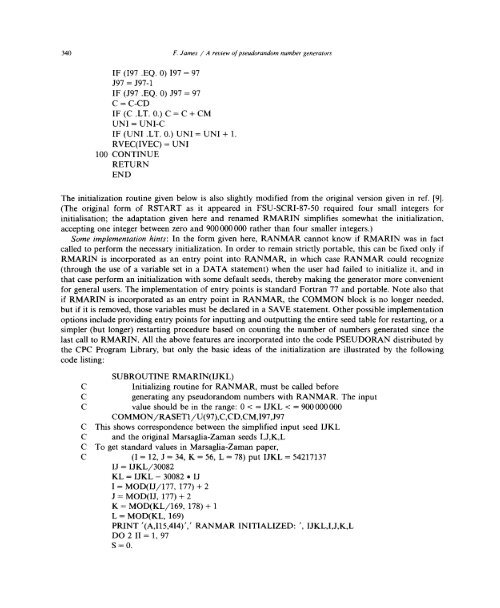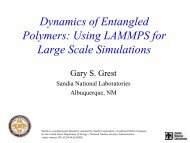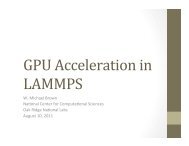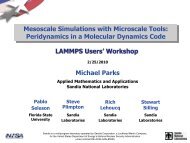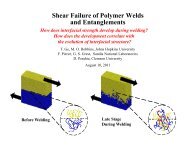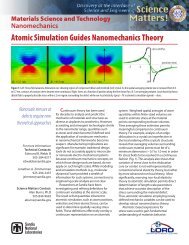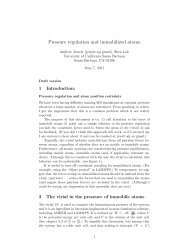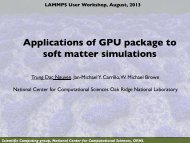A review of pseudorandom number generators - Lammps
A review of pseudorandom number generators - Lammps
A review of pseudorandom number generators - Lammps
You also want an ePaper? Increase the reach of your titles
YUMPU automatically turns print PDFs into web optimized ePapers that Google loves.
340 F. James / A <strong>review</strong> <strong>of</strong><strong>pseudorandom</strong> <strong>number</strong> <strong>generators</strong><br />
IF (197 EQ. 0)197 = 97<br />
J97 = J97-1<br />
IF (J97 .EQ. 0) J97 = 97<br />
C = C-CD<br />
IF (C .LT. 0.) C = C + CM<br />
UNI = UNI-C<br />
IF (UNI .LT. 0.) UNI = UNI +1.<br />
RVEC(IVEC) = UN!<br />
100 CONTINUE<br />
RETURN<br />
END<br />
The initialization routine given below is also slightly modified from the original version given in ref. [9].<br />
(The original form <strong>of</strong> RSTART as it appeared in FSU-SCRI-87-50 required four small integers for<br />
initialisation; the adaptation given here and renamed RMARIN simplifies somewhat the initialization,<br />
accepting one integer between zero and 900 000 000 rather than four smaller integers.)<br />
Some implementation hints: In the form given here, RANMAR cannot know if RMARIN was in fact<br />
called to perform the necessary initialization. In order to remain strictly portable, this can be fixed only if<br />
RMARIN is incorporated as an entry point into RANMAR, in which case RANMAR could recognize<br />
(through the use <strong>of</strong> a variable set in a DATA statement) when the user had failed to initialize it, and in<br />
that case perform an initialization with some default seeds, thereby making the generator more convenient<br />
for general users. The implementation <strong>of</strong> entry points is standard Fortran 77 and portable. Note also that<br />
if RMARIN is incorporated as an entry point in RANMAR, the COMMON block is no longer needed,<br />
but if it is removed, those variables must be declared in a SAVE statement. Other possible implementation<br />
options include providing entry points for inputting and outputting the entire seed table for restarting, or a<br />
simpler (but longer) restarting procedure based on counting the <strong>number</strong> <strong>of</strong> <strong>number</strong>s generated since the<br />
last call to RMARIN. All the above features are incorporated into the code PSEUDORAN distributed by<br />
the CPC Program Library, but only the basic ideas <strong>of</strong> the initialization are illustrated by the following<br />
code listing:<br />
SUBROUTINE RMARIN(!JKL)<br />
C<br />
Initializing routine for RANMAR, must be called before<br />
C<br />
generating any <strong>pseudorandom</strong> <strong>number</strong>s with RANMAR. The input<br />
C value should be in the range: 0 < = IJKL < = 900 000 000<br />
COMMON/RASETI /U(97),C,CD,CM,197,J97<br />
C This shows correspondence between the simplified input seed IJKL<br />
C and the original Marsaglia-Zaman seeds I,J,K,L<br />
C To get standard values in Marsaglia-Zaman paper,<br />
C (I = 12, J = 34, K = 56, L = 78) put IJKL = 54217137<br />
IJ = IJKL/30082<br />
KL = IJKL — 30082 * IJ<br />
I = MOD(IJ/177, 177) + 2<br />
J = MOD(IJ, 177) + 2<br />
K = MOD(KL/169, 178) +1<br />
L = MOD(KL, 169)<br />
PRINT ‘(A,I15,4!4)’,’ RANMAR INITIALIZED: ‘, IJKL,I,J,K,L<br />
DO 2 II = 1, 97<br />
S = 0.


